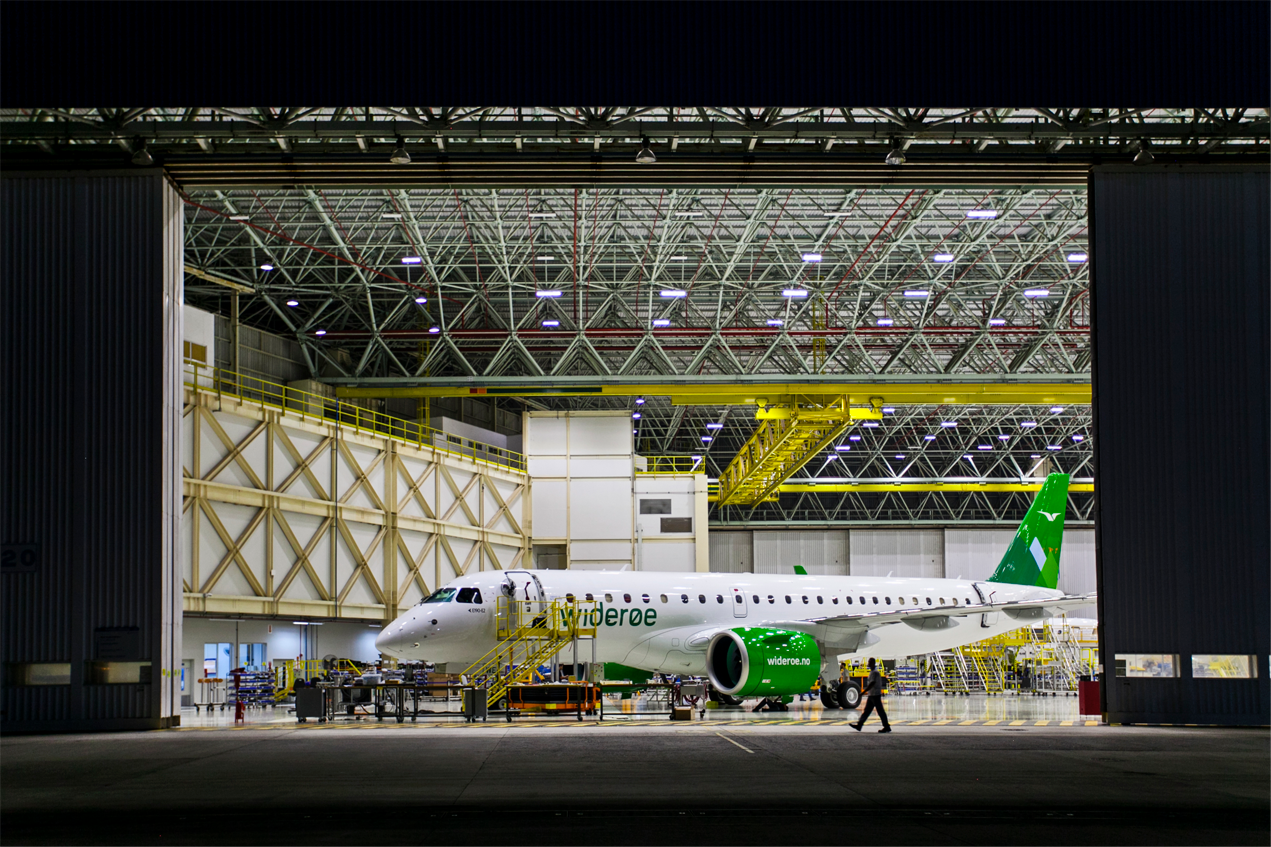
It’s many a year now since engineering products were simply manufactured and sold, sometimes with a guarantee. Nowadays however, make a sale of such products without support products being offered is incredibly rare.
It has certainly been the case in the airline industry that if you don’t offer strong aftersales support programs, the actual sale may not proceed. Besides, there are cases where the product is a loss-leader and the profits are made in the aftermarket.
As the presence in the industry of crossover narrowbody jets such as the Airbus A220 family and the Embraer E-Jet family (now into its second generation, the E2) continues to grow, their manufacturers have programs which they believe can suit all their customer operators.
Johann Bordais, president and CEO of Embraer Services & Support, outlines the way the company creates an E-Jet support package, noting the key starting points and the subsequent building blocks. “A multitude of factors guides the offering to a customer – from the level of relationship with Embraer to the phase of the product lifecycle for that given customer,” he begins. “Any offer starts from a deep understanding of the customer’s needs at that given moment and how the customers envision E-Jets contributing in the long run.
“For instance, for a new customer introducing E-Jets, the first step of the discussion is to understand its strategy. Is the customer an outsourcer or does it insource? Does the customer prefer a solution that protects its cash flow in the long-term or have short-term transactional ad-hoc goals? Who are the key end customers? What is the mission and vision? Depending on the product mission, the customer’s vision for differentiation, cost efficiency among other key-value points, Embraer works on analyzing products and services that deliver on the customer’s vision.
“Embraer has multiple solutions that can be tailored to the specific customer’s needs and deliver targeted value to the operation,” Bordais continues. “These range from an aircraft enhancement that will enable the customer to have greater range and better performance to the ability to rely on the knowledge of the experts behind E-Jet design and operation who offer unmatched consultancy services to extract full potential from the aircraft.”
On the material services front, Embraer has flexibility to offer parts exchange on an ad-hoc basis, expendables parts management on a VMI (vendor-managed inventory) basis, Time and Material repair management solutions, and finally, an encompassing flight-hour based pool program that offers high quality and modification standard parts. “These would have an average age of less than six years due to Embraer’s commitment to keeping its pool exclusive inventory fresh and updated to the latest configuration,” Bordais notes.
“In specific regions, such as Africa, Embraer can offer flight and cabin crew training through its training center in Johannesburg. From pilots initial training, to transition to dry FFS (full flight simulator) leasing, we’re always working on being the option of choice to E-Jet customers,” he adds.
While the company has its broad range of solutions, what matters the most to Embraer, according to Bordais, is to understand what is important to an individual customer at any particular moment.
Just as at Embraer, the first step for Airbus in creating a Tailored Support Package (TSP) package is also to understand the customer’s needs. “Each customer requirement will deviate in some manner from the previous customer requirement,” reports Martin Elliott, head of A220 customer services, Airbus Canada. “The starting point is to conduct a detailed analysis with our customer on what their current strengths and weaknesses are in such areas as maintenance, engineering, repair capability, backshops, parts depot, hanger space, and so on. Based upon this analysis we provide our customer with the most economical proposal to minimize the cost to their operation and in parallel maximize their efficiency,” he remarks.
“The main building blocks for a TSP consist of: all type of material from consumables and expendables (C&E) up to LRUs (line replacement units) being under PBH (power-by-the-hour); fleet technical management; and line and base maintenance. Specifically for the A220, we have started with the building blocks which offer PBH solutions for C&E and LRU. We work continuously with our suppliers to enhance and evolve our services to offer proposals to bring maximum value for our customers,” Elliott adds.
Support to customers, of course, must be available wherever they are and where they fly. Airbus has major support centers of its own around the world plus a number of authorized service centers. Richard Ward, A220 program manager, flight hour services for Airbus explains how the location for MRO work between all these centers is decided.
“Within Airbus we have a Steerco Team in place, membership of which is composed of the various Airbus functional teams that interact with our customers on their maintenance requirements. The team has a monthly meeting whereby we review current customer MRO needs and in parallel we review potential customer future needs based upon sales in the region,” Ward explains. “Based upon this analysis we will set up a potential readiness review with potential MROs in a region to support our product. The first heavy maintenance requirement is typically at least three years from entry into service, so there is plenty of time to arrange support from a suitable MRO and with the growing sales of the A220. There is significant interest from MROs to support our product.”
In the area of global material support and services for A220 operators, Satair, an Airbus services company, has taken the lead since July 2020, working in close coordination with the A220 program team at Airbus Canada. The OEM states that “Satair's worldwide presence and breadth of expertise in supporting the whole Airbus fleet provides best in class material availability and support to A220 customers on structural parts as well as equipment, tooling and hardware”. Meanwhile a new network for the repair of structural parts is being set up as Airbus continuously scales the material support to the A220.

Embraer has a network of Owned and Authorized service centers that span the globe to support its Commercial Aviation customers. “The Owned Service Center Network is strategically placed in locations that support most of the operations – North America, South America and Europe,” says Bordais.
“In North America, the two centers are in Nashville, TN, and Macon, GA, which are collectively known as Embraer Aircraft Maintenance Services (EAMS). In South America, we have a Centre of Excellence to support all three business sectors: Executive, Defense and Commercial, located in Sorocaba, Brazil. OGMA is located close to Lisbon, Portugal, to support the Europe, Middle East and Africa region,” he elaborates. “Those facilities have extensive product experience and can provide significant peace of mind to customers that may want to rely on a one-stop-shop solution. As noted, we also have a series of affiliated MROs that complement the owned service centers.”
Bordais stresses how having these centers strategically placed allows Embraer to divide work to support its customers in the regions where they utilize their aircraft. “We understand the burden of having to move an aircraft [for MRO] is a heavy one and want to reduce that burden by being on three separate continents. All discussions with MRO customers always begin with an understanding of where the aircraft fly, where they are coming from and where they will go to. With this data, we can make informed suggestions to the customer regarding which center can provide support,” he states.
As might be expected as OEMS, both Airbus and Embraer are instrumental in many of the repairs designed for their products. According to Bordais, Embraer Services & Support is typically involved in the design of repairs to support requests from the MROs and airlines during scheduled or unscheduled maintenance. Repairs, of course, can be created by the OEM, the customer or the MRO doing the maintenance for an operator.
“We have an open channel with the MROs through our Return To Service (RTS) team that operates 24 x 7, 365 days a year. As a general guidance, we highly recommend that the MROs suggest feasible repairs when submitting a request for a technical disposition to the RTS team. This helps streamline the repair design process based on the materials and capabilities available at a given location,” Bordais comments. “Embraer then evaluates the proposed solution and provides a final disposition. Periodically that information is fed back to the Structural Repair Manual for the most relevant/frequent repairs so the fleet can benefit from the accumulated knowledge.”
Within Airbus, repairs are produced firstly based upon historical requirements from existing in-service platforms and secondly based upon any special requirements that the introduction of a new aircraft type brings. “Also, as part of the process we are in close contact with the other Airbus platforms on any R&D that they have performed or will perform that will allow the introduction of additional reworks that can be made applicable to the A220,” remarks Elliott.
“Furthermore, we have ongoing meetings with our customers whom will provide both input on the type of future repairs that they may require along with the priority for these repairs,” he continues. “Typical service centers will ask for our approval for their repairs, hence we have all the information to make them available in our repair manuals and for the few developed outside this process we are happy to review with the service center incorporation into our manuals.”
MRO requirements are continually reviewed by Airbus based upon customer needs in the various regions throughout the world. Samco, located in the Netherlands, was an early A220 Authorized Service Facility and has been used by customers have used to support both line and heavy maintenance. Meanwhile Avianor, in Canada, has independently obtained MRO approval for both line and heavy checks on the A220.
Developments in support networks, as exemplified by both Embraer and Airbus, are going to be key to the success of these types if, as predicted by a number of observers, they are going to play a key role in the post-Covid air transport market.





